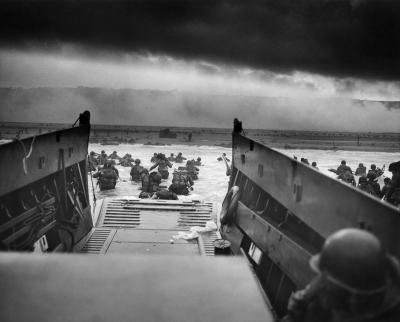Operation Overlord was the codename for the Battle of Normandy, the Allied operation that launched the successful invasion of German-occupied Western Europe during World War II. The operation was launched on 6 June 1944 with the Normandy Landings (D-Day). A 1,200-plane airborne assault preceded an amphibious assault involving more than 5,000 vessels. Nearly 160,000 troops crossed the English Channel on 6 June, and more than two million Allied troops were in France by the end of August.
The decision to undertake a cross-channel invasion in 1944 was taken at the Trident Conference in Washington in May 1943. General Dwight D. Eisenhower was appointed commander of Supreme Headquarters Allied Expeditionary Force, and General Bernard Montgomery was named as commander of the 21st Army Group, which comprised all the land forces involved in the invasion. The coast of Normandy of northwestern France was chosen as the site of the invasion, with the Americans assigned to land at sectors codenamed Utah and Omaha, the British at Sword and Gold, and the Canadians at Juno. To meet the conditions expected on the Normandy beachhead, special technology was developed, including two artificial ports called Mulberry harbours and an array of specialised tanks nicknamed Hobart's Funnies. In the months leading up to the invasion, the Allies conducted Operation Bodyguard, a substantial military deception that used electronic and visual misinformation to mislead the Germans as to the date and location of the main Allied landings. Fhrer Adolf Hitler placed German Field Marshal Erwin Rommel in charge of developing fortifications all along Hitler's proclaimed Atlantic Wall in anticipation of an invasion.
The Allies failed to accomplish their objectives for the first day, but gained a tenuous foothold that they gradually expanded when they captured the port at Cherbourg on 26 June and the city of Caen on 21 July. A failed counterattack by German forces on 8 August left 50,000 soldiers of the German 7th Army trapped in the Falaise pocket. The Allies launched a second invasion from the Mediterranean Sea of southern France (code-named Operation Dragoon) on 15 August, and the Liberation of Paris followed on 25 August. German forces retreated east across the Seine on 30 August 1944, marking the close of Operation Overlord.
The Normandy landings were the landing operations and associated airborne operations on Tuesday, 6 June 1944 of the Allied invasion of Normandy in Operation Overlord during World War II. Codenamed Operation Neptune and often referred to as D-Day, it was the largest seaborne invasion in history. The operation began the liberation of France (and later western Europe) and laid the foundations of the Allied victory on the Western Front.
Planning for the operation began in 1943. In the months leading up to the invasion, the Allies conducted a substantial military deception, codenamed Operation Bodyguard, to mislead the Germans as to the date and location of the main Allied landings. The weather on D-Day was far from ideal, and the operation had to be delayed 24 hours; a further postponement would have meant a delay of at least two weeks, as the invasion planners had requirements for the phase of the moon, the tides, and the time of day that meant only a few days each month were deemed suitable. Adolf Hitler placed Field Marshal Erwin Rommel in command of German forces and of developing fortifications along the Atlantic Wall in anticipation of an Allied invasion. U.S. President Franklin D. Roosevelt placed Major General Dwight D. Eisenhower in command of Allied forces.
The amphibious landings were preceded by extensive aerial and naval bombardment and an airborne assault—the landing of 24,000 American, British, and Canadian airborne troops shortly after midnight. Allied infantry and armoured divisions began landing on the coast of France at 06:30. The target 50-mile (80 km) stretch of the Normandy coast was divided into five sectors: Utah, Omaha, Gold, Juno, and Sword. Strong winds blew the landing craft east of their intended positions, particularly at Utah and Omaha. The men landed under heavy fire from gun emplacements overlooking the beaches, and the shore was mined and covered with obstacles such as wooden stakes, metal tripods, and barbed wire, making the work of the beach-clearing teams difficult and dangerous. Casualties were heaviest at Omaha, with its high cliffs. At Gold, Juno, and Sword, several fortified towns were cleared in house-to-house fighting, and two major gun emplacements at Gold were disabled using specialised tanks.
The Allies failed to achieve any of their goals on the first day. Carentan, Saint-Lô, and Bayeux remained in German hands, and Caen, a major objective, was not captured until 21 July. Only two of the beaches (Juno and Gold) were linked on the first day, and all five beachheads were not connected until 12 June; however, the operation gained a foothold that the Allies gradually expanded over the coming months. German casualties on D-Day have been estimated at 4,000 to 9,000 men. Allied casualties were documented for at least 10,000, with 4,414 confirmed dead. Museums, memorials, and war cemeteries in the area now host many visitors each year.

1944Jun, 6
World War II: The Battle of Normandy begins. D-Day, code named Operation Overlord, commences with the landing of 155,000 Allied troops on the beaches of Normandy in France. The allied soldiers quickly break through the Atlantic Wall and push inland in the largest amphibious military operation in history.
Choose Another Date
Events on 1944
- 10Apr
Auschwitz concentration camp
Rudolf Vrba and Alfréd Wetzler escape from Birkenau death camp. - 13Apr
Soviet Union
Diplomatic relations between New Zealand and the Soviet Union are established. - 26Jun
RAF
World War II: San Marino, a neutral state, is mistakenly bombed by the RAF based on faulty information, leading to 35 civilian deaths. - 26Aug
Charles de Gaulle
World War II: Charles de Gaulle enters Paris. - 31Dec
Nazi Germany
World War II: Hungary declares war on Nazi Germany.

 English
English  español
español  français
français  português
português  русский
русский  العربية
العربية  简体中文
简体中文 